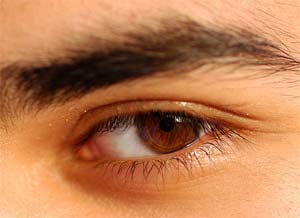Among the causes of eyelid inflammation are not only bacteria and fungi but also… lice. These lice are very small and can only be seen under a microscope.
 |
|
It’s recommended to clean your eyelids twice a day. |
Look in the mirror or at the eyes of someone close to you (gently pull the upper eyelid with your thumb and the lower eyelid with your index finger). The area resembling the lip of a fish is the eyelid margin. The eyelid margin is the transitional zone between the skin of the eyelid at the front and the conjunctiva of the eyelid (also known as the mucous membrane of the eyelid) at the back. The eyelid margin has openings for sebaceous glands and some other glands. Near the root of the nose on the eyelid margin, there is a small opening (one on the upper eyelid and one on the lower eyelid) known as the lacrimal punctum or tear duct. This is the channel that leads tears down to the nose. Eyelashes grow on the skin of the eyelid, close to the eyelid margin, rather than on the eyelid margin itself.
The eyelid margin is rarely clean and often has a greasy and swollen appearance because it is exposed to the front, always in contact with dust, sunlight, and various harmful gases from daily activities (gasoline fumes, coal smoke, etc.).
The specific pathogens of eyelid inflammation commonly encountered are bacteria, pityrosporum yeast, and eyelash lice (if you pluck an eyelash and examine it under a microscope, you will see the lice clinging to it like grasshoppers clinging to the base of rice or cassava).
Do not confuse eyelash lice with pubic lice. Pubic lice are similar to body lice; they are larger and can be seen with the naked eye. Eyelash lice, on the other hand, are microscopic and can only be seen through a microscope.
Do not panic or be surprised. If you experience itchy eyes, you might rub your eyes or tug at your eyelashes to relieve the itch, and if an eyelash falls out and is examined under a microscope, it will usually reveal the presence of lice. Other hairy animals such as cats, dogs, and sheep also commonly have lice on their fur.
To treat eyelid inflammation, it is advisable to wash your face twice a day (before leaving for work in the morning and after returning home in the afternoon). Washing your face with a wrung-out towel will help remove dirt. A gentle wipe over the eyes also helps to express the dirt and oil from the eyelid margin.
After washing your face in the morning, instill a few drops of 0.4% chlorhexidine. Chlorhexidine has a broad antibacterial spectrum and can kill many types of bacteria.
If your eyes are too itchy, it is advisable to apply tetracycline eye ointment. This medication reduces excessive secretion from the sebaceous glands. The vaseline in the ointment blocks the respiratory passages of the eyelash lice, leading to their destruction.
Dr. Hoàng Sinh


















































